2.
GHANA
Export contract approvals drop in second quarter
The Timber Industry Development Division (TIDD) of the
Ghana Forestry Commission is reporting that contract
approvals fell in the second quarter of the year. A total
contract volume of 88,869cu.m was processed and
approved during the second quarter and this represented a
decline of 7% compared to the volume of approved
contracts in the first quarter.
The largest drop was in approvals for air- and kiln-dried
sawnwood which fell by 21% to 28,530 cu.m from 36,190
cu.m in the first quarter.
Export contract approvals for plywood also fell in the
second quarter dropping 12% to 30,370 cu.m compared to
the 34,360 cu.m in the first quarter.
In contrast, export approvals for rotary and sliced veneer
increased as did approvals for the export of teak poles,
billets and logs.
The volume of exports of teak poles, billets and logs
increased from a volume of 10,020 cu.m in the first
quarter to 13,320 cu.m in the second quarter representing
an increase of over 30%.
The table below shows the distribution of contract
approvals in the first and second quarters of this year.
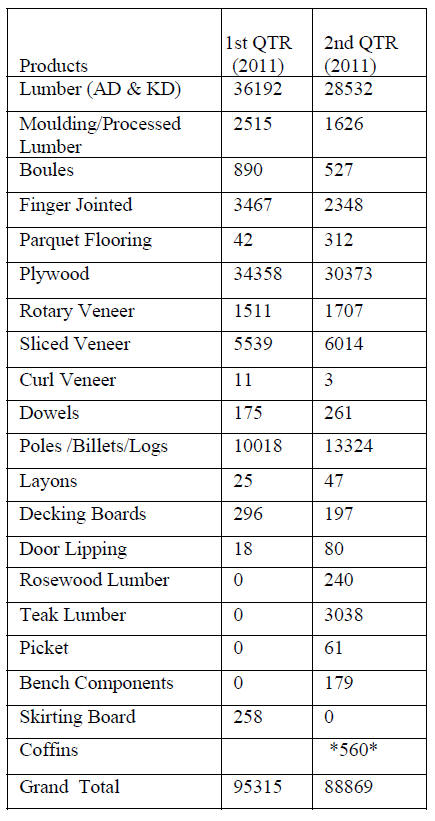
Minimum trading prices revised upwards
The Guiding Selling Pricing Committee of the TIDD has
increased the Guiding Selling Prices (GSP) of wood
products for export so as to better reflect the prevailing
market conditions and Euro exchange rates.
Sawnwood prices were raised for Denya (€360 to €400),
Ekki (€360 to €370), Mahogany K.ivorensis (€554 to
€559), and Sapele (€545 to €555). The committee also
announced a €10 per cu.m increase in the minimum export
price of plywood of all sizes, thickness and species.
Despite these increases, exporters were able to negotiate
sales contracts at the revised levels for the West African
market, especially for the Nigerian market. Most exporters
secured prices over and above the minimum rate.
However, exporters were generally unable to meet the
GSP for plywood of CC/CC quality in the same market.
Most exporters found that they could not meet the GSP for
Wawa sawnwood for Asian and Middle East markets and
the contracts submitted for approval were between 4 -8%
below the GSP. In the case of Mahogany for the US
market it was found that the GSP was between 7-11%
higher than the best prices offered.
Most lesser used species continue to find markets in the
Middle East and Asian countries. With the exception of
Denya, exporters were unable to achieve the GSP for other
LUS, particularly Celtis, Yaya and Otie for the same
markets.
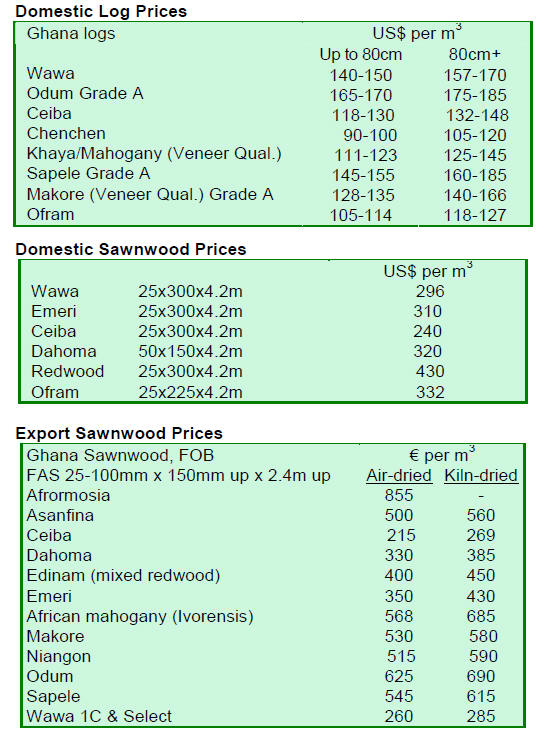
3.
MALAYSIA
Exporters fear another downturn in the US economy
Malaysian timber exports slowed in the first four months
of this year and timber exporters in the country are wary of
a yet another economic downturn in the US that could
impact timber markets around the world as in 2009.
According to preliminary statistics released by the
Malaysian Timber Industry Board (MTIB), exports of
sawnwood amounted to RM786 million for the first four
months of 2011, a decline of 7.8% compared to the same
period in 2010. Volume-wise, the decline was 4.4%.
Compared to levels in the first half of 2010 log exports in
the same period of 2011 were down by 18.7% at RM625
million.
However, exports of builders¡¯ woodwork and joinery rose
by 12% to RM338 million and fibreboard exports
registered an increase of 8% to RM393 million for the
January to April period in 2011 compared to levels in the
same period of 2010.
Plywood imports by Japan slow as inventories are assessed
Japanese imports of Malaysian plywood have slowed as
plywood importers evaluate their inventories. News is
circulating that some importers have run out of storage
space in their warehouses.
According to statistics released by the Sarawak Timber
Industry Development Corporation (STIDC), Sarawak¡¯s
exports of plywood to Japan amounted to RM476 million
in the first quarter of this year. However, exports of
plywood rose to RM926 million in the second quarter, an
increase of more than 65% compared to levels in the same
period last year.
Sarawak plywood exporters are projecting an increase in
the demand for plywood well into 2012.
Flow of logs to Sarawak mills back to normal
The STIDC has indicated that the flow of logs to domestic
mills has returned to normal and that the plywood mills in
Sarawak, with a combined capacity of 4 million cu.m, are
now operating at about 70% of capacity.
Sarawak¡¯s exports of plywood to South Korea, its second
largest market after Japan, fell from RM107 million in the
first quarter of this year to RM55 million in the second
quarter.
This was due to the imposition of anti-dumping duties by
the South Korea Trade Commission placed on plywood of
Sarawak origin after complaints filed by the South Korean
Wood Panel Association.
Nevertheless, Sarawak exported RM2.1 billion worth of
panel-products in the first half of this year compared to
RM1.95 billion in the same period last year. The volume
of panel products exported during the first half of this year
was only 1.3 million cu.m, whereas the volume exported
during the same period last year totaled 1.46 million cu.m.
Taiwan P.o.C was the third largest export destination for
plywood from Sarawak in the first half of this year with
imports valued at RM147.5 million for a volume of
112,900 cu.m. The Philippines is the fourth largest market
at RM56 million (34,360 cu.m).
Exports to countries in the Middle-East picked in the first
half of the year with Egypt importing some RM40 million
(26,270 cu.m) and Yemen importing RM31 million
(25,360 cu.m).
Correction
In our last issue we used the caption: China the largest
importer of Malaysian furniture. This should have read:
China the fastest growing market for Malaysian furniture
With 85 per cent of Malaysia¡¯s furniture being exported
manufacturers are constantly looking for new market
opportunities, especially in the non-traditional Asian
markets such as China and India.
In 2010, China imported wooden furniture from Malaysia
valued at RM18. 9 mil (US$63 mil.); this represented an
83% increase on 2009 figures. In addition, Malaysian
exports of wooden furniture to Hong Kong SAR in 2010
were RM17, 8 mil. (US$5,9mil.), up 20% on 2009.
In contrast, exports of wooden furniture to the US grew by
only 7% in 2010 while exports of all furniture (wooden,
plastic, metal) to the US for the period January to May
2011 contracted by 24%. This contraction is expected to
continue for the rest of the year.
Malaysia¡¯s top 10 furniture export markets in 2010, which
were worth RM4.78 billion, were the US, Japan,
Singapore, UK, Australia, Canada, United Arab Emirates,
India, Saudi Arabia and Germany.
Apologies
Apologies are extended the Council of Asia Pacific
Furniture Associations (CAPFA) which, in our last issue,
was erroneously referred to as the Council of Asian
Furniture Associations (CAFA).
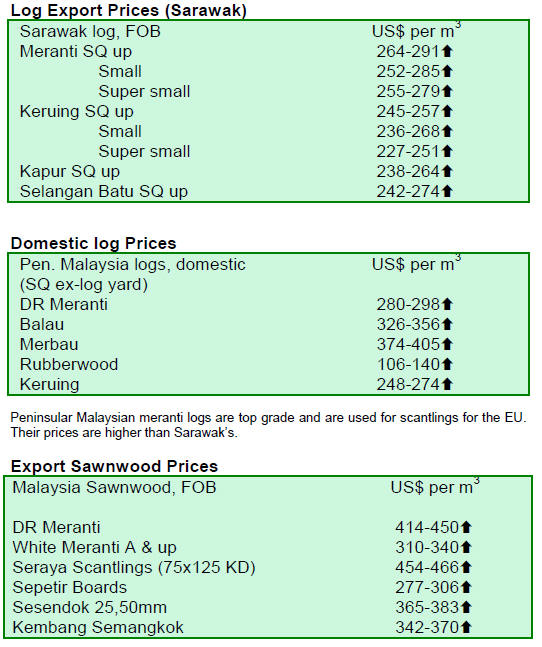
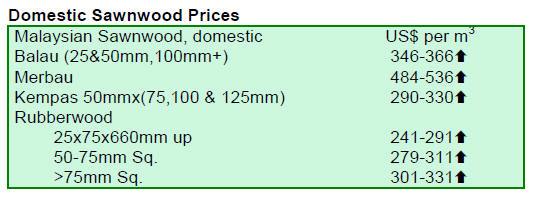
4.
INDONESIA
Successful implementation of
legal origin verification
to ensure market access to the EU
Indonesia stands to gain from having implemented a
system to verify the legality of its timber supply chain
according to an official from the Multi-stakeholder
Forestry Programme (MFP).
The successful implementation of this verification
process
will ensure that by 2013 all Indonesian timber and timber
products entering the European Union (EU) are of legal
origin.
The MFP speculated that enforcement of the EU Forestry
legislation may result in a shortage of timber entering the
EU market, thus pushing prices higher. This, in turn, will
benefit Indonesian exporters, as Indonesia is well placed to
fill the gap in the supply of legal timber.
The supply chain verification system in Indonesia was
initiated in 2003 before it was incorporated into the
Indonesian forestry ministry decree in 2009.
At this time guidelines for the evaluation processes
for
production, forest management and legal timber
verification were established.
To-date, both primary forest areas and commercial
forest
plantations in Blora and Wonosobo, in Central Java, and
Gunungkidul in Yogyakarta have achieved the required
standard and have been so certified.
Indonesia is planning to move its timber industry into
more downstream processing through the application of
the certification system to timber processors.
Provincial forestry offices to get funds to improve
forest fire fighting capacity
The Indonesian Forestry Ministry has reportedly set aside
up to Rp.164 billion to address the problem of forest fires.
Some Rp.9 billion will be distributed to 33 provincial
forestry offices to increase regional forest fire fighting
capacity.
The intense haze emitted every year from fires on
farmland and peat lands in Indonesia has been a bone of
contention between Indonesia and its neighbouring
countries for many years. In addition to the health hazard
posed by the smoke, the tourism sectors in Singapore and
Malaysia are also affected.
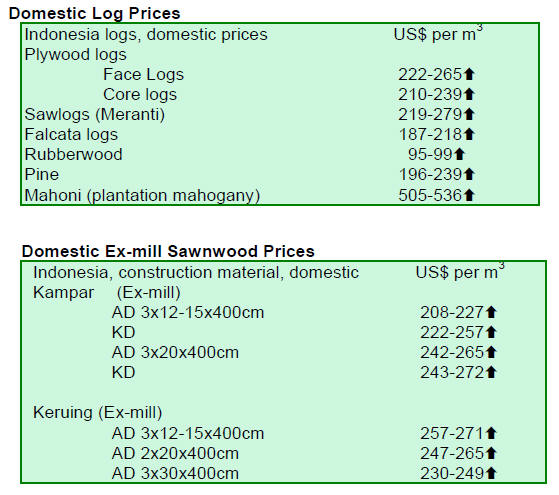
5. MYANMAR
Teak market remains subdued
Analysts report that market demand for both teak and
pyinkadoe has fallen and that there is considerable
weakness in the market. Some traders supplying the Indian
market report a decline in teak purchases by Indian
importers, attributing this to price factors. In contrast
demand for Gurjan remains firm.
Myanmar timber merchants to seek reduced export
taxes for wood products
The recent announcement by the Myanmar Government
about a further reduction of the export tax from 7 per cent
to 2 per cent was not received with enthusiasm by the
timber sector.
The items to which the reduced tax levels apply are
agricultural produce, marine products and animal
products, timber products are not included.
Myanmar timber merchants are reportedly preparing to
appeal to the government to include timber and forest
products in the list of products to which reduced export
taxes apply.
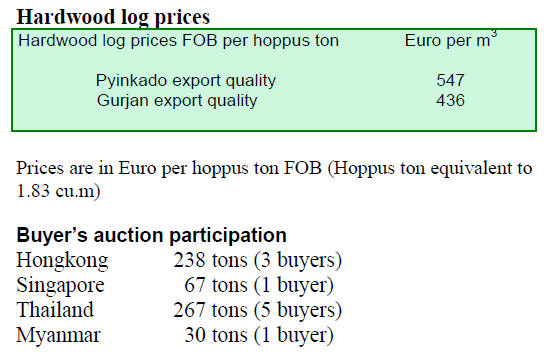
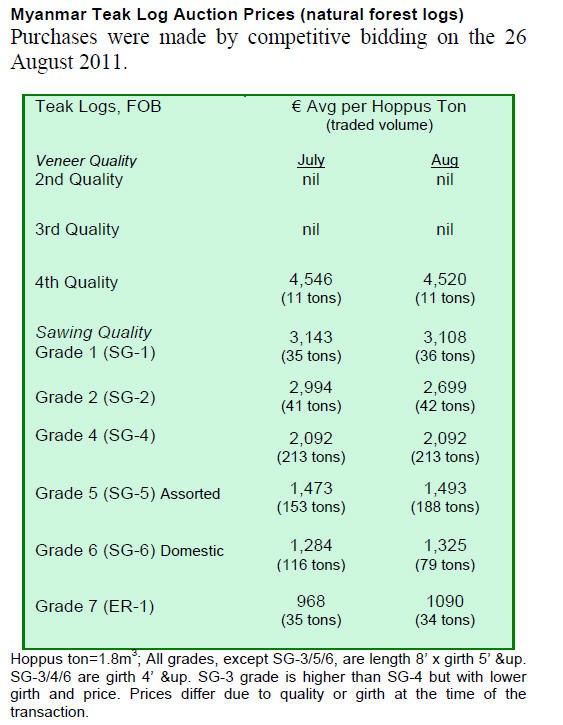
6. INDIA
Log auction sales end in Central
Province depots
Auction sales of domestic logs have now ended for the
current season in the Jabalpur, Hoshangabad and Betul
forest division depots. Log auctions will resume after the
Diwali holidays towards the end of October. There was
active buying during the final sales and prices were firm.
July exports reach a record high
Figures released by the Ministry of Commerce show that
exports in July were a record high of US$29.3 billion, an
increase of over 80% on the level in the same month in
2010.
July imports also increased sharply rising to US$40
billion, up by 51% against the figures for July last year.
India's total merchandise exports for the period
April-July
stood at US$108.3 billion, registering a growth of 54%.
Similarly, cumulative imports reached US$151 billion, up
by 40% compared to the same period last year. Exports to
African countries have increased, almost doubling
compared to levels 12 months ago.
Pace of inflation slowing consumption and
investment
Economists have lowered their growth projections for the
Indian economy and at the same time raised inflation
forecasts. Around two months ago annual growth was
being projected at over 8% but the latest analysis suggests
an annual growth of around 7.5-7.8%.
In the first quarter the Indian economy grew 7.6%
from a
year ago, the slowest pace in five quarters. One reason
quoted for the decline is rising interest rates which have
affected consumer spending and company investment.
Inflation in India is still at around 9 percent
despite the
action by the Bank of India which has raised interest rates
ten times since March 2010.
House price correction expected in Mumbai and
Delhi
Analysts are of the opinion that house prices in India are
set to decline by as much as 15% as there is an apparent
oversupply at present. This is putting pressure on house
builders to quickly dispose of their housing stocks because
interest rates continue to climb creating a huge debt in the
house building sector. The forecasts are for a correction to
begin in the Mumbai and the Delhi areas.
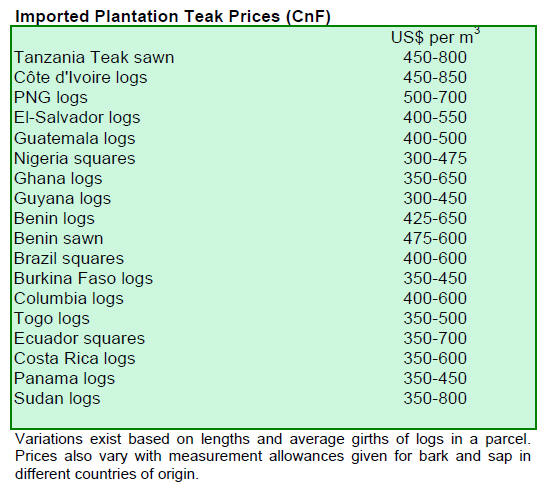
Demand from Europe, USA and Middle East for teak and
other hardwoods remains steady.
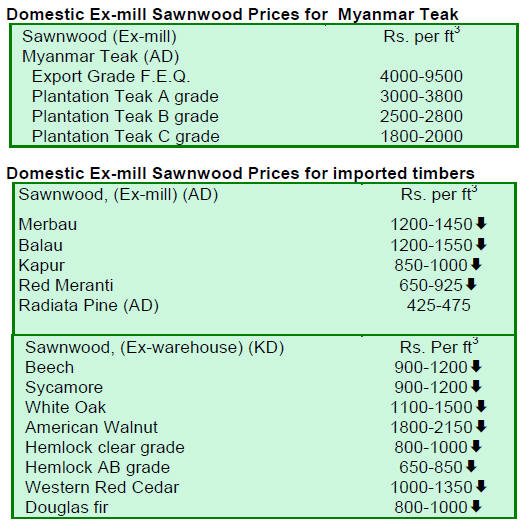
Monsoon season celebrated with tree planting
As is customary in India, August is the month for
celebrating the arrival of the monsoon rains by planting as
many new saplings as possible, in India this is termed
Vana-mahotsava (Festival of forest plantings).
Forest departments, non government agencies,
panchayats
(local city councils), schools, road building and
maintenance departments all undertake planting to
enhance the greening of their localities.
Millions of trees are planted through public support
in the
cities and moffusil (rural districts) areas. Tree saplings are
provided by all state forest department nurseries generally
free of charge.
Species provided by the Forestry Department include
Teak, Gamhar (Gmelina arborea) all species of
Terminalia, Rosewood ( Dalbergia latifolia and D.sissoo )
and some bamboo species.
The Irrigation Department plants saplings of
Dalbergia
sissoo, various species of Acacia and Neem (Melia
azadirechta) to stabilize canal banks.
Village authorities encourage the planting of fruit
species
such as Mango, Eugenia, Mimusops, Tamarind and Neem
as well as flowering species such as Cassias, Albizias,
Lagerstroemia and Poinciana.
7. BRAZIL
Inflation rises and the Real
continues to appreciate
against the US dollar
The National Consumer Price Index (IPCA), from which
the official inflation rate in Brazil is determined, was
0.16% in July, close to the figure for June (0.15%). This
means that the rate of inflation has risen to almost 7% in
12 months.
he average exchange rate for the Real in July 2011
was
BRL 1.56 per US dollar reflecting a further appreciation of
the Brazilian currency against the US dollar.
July wood product exports fall across the board
In July 2011, exports of timber products (except pulp and
paper) fell 18.7% compared to values in July 2010, from
US$ 266.7 million to US$ 184.3 million.
Pine sawnwood exports declined 3.6% in value in
July
2011 compared to levels in July 2010, from US$ 16.5
million to US$ 15.9 million. In terms of volume, July
exports dropped 7.6%, from 72,500 cu.m to 67,000 cu.m.
Exports of tropical sawnwood also fell in terms of
both
volume and in value, from 45,400 cu.m in July 2010 to
31,200 cu.m in July 2011 and from US$ 21.1 million to
US$ 16.1 million. This translates to a 24% decrease in
value and 31% drop in volume.
Following the overall trend, pine plywood exports
also fell
in July dropping by 29% in value from US$ 29.8 million
to US$ 21.1 million. Export volumes were down a massive
33% in July 2011 compared to levels in July 2010,
declining from 80,000 cu.m to 53,600 cu.m.
Exports of tropical plywood fell from 8,800 cu.m in
July
2010 to 6,500 cu.m in July 2011, a 26% decrease. In terms
of value a 19% decline was registered (from US$ 4.7
million to US$ 3.8 million).
Furniture export levels followed the trend observed
for
other wood product exports by declining from US$ 49.4
million in June 2010 to US$ 41.7 million in July 2011
(-5.6%).
Furniture manufacturers expand sales to Saudi
Arabia
Furniture exporters in the Ub¨¢ municipality, Minas Gerais,
have succeeded with exports to Saudi Arabia where
monthly imports from Ub¨¢ municipality currently average
around US$200,000. Analysts suggest that for 2011 as a
whole sales could average US$ 250,000 per month.
The main item imported into Saudi Arabia from Minas
Gerais is beds supplied without headboards. A variety of
wood finishes are offered with the eucalyptus frame being
veneered with timbers such as sucupira, cherry and
mahogany.
However, Saudi Arabia is not the only country
importing
furniture manufactured in the Ub¨¢ region. According to
the Association of Retailers and Representatives of the
Furniture Sector of Minas Gerais (Alormov), the United
States is the largest market for furniture produced in Ub¨¢
as exports average US$2 million a month. Exports to Italy,
the second largest market, are around US$600,000 each
month.
The Ub¨¢ region has approximately 450 furniture
manufacturers, selling between R$300,000 (US$186,000)
and R$400,000 (US$248,000) a month. Average monthly
revenue is estimated at around R$135 million (US$ 84
million) while total furniture exports are over US$10
million a month.
Amazon production redirected away from export
markets to satisfy domestic demand
The booming economy and especially expenditure in the
construction sector in Brazil is driving up domestic timber
consumption. This, in turn, has resulted in a change in the
wood products sector as much of the timber from the
Amazon that was once destined for export is now
redirected to the domestic market. The knock-on effect of
this is to cause prices for Brazilian timber products in the
international markets to rise.
Brazil is the one of the main suppliers of tropical
timber to
Europe but, as more Brazilian timber production begins to
be used locally, exports will likely decline in the coming
years, however, production will remain high due to strong
domestic demand.
Satellite monitoring to combat forest
degradation and deforestation
A forest monitoring system managed by IDEFLOR
(Center for Monitoring Forest Development) in Para State
has, since 2008, been used to conduct surveys of the
State's public forests.
Analysis over time has been used to identify
deforestation
occurring in the forests of Para State. There were cases of
severe forest degradation in the late eighties but recent
satellite analysis is showing forest regeneration in the
affected areas according to IDEFLOR.
Deforestation and degradation stems from
clear-cutting,
selective logging and the opening of roads as well as the
building of clandestine airstrips.
When deforestation is detected IDEFLOR conducts
operations in the State based on the analysis obtained via
satellite. Currently an operation is under way in the
western region of Par¨¢ State where the environmental
agencies inspected an area of approximately 33,000
hectares and evicted illegal loggers and squatters.
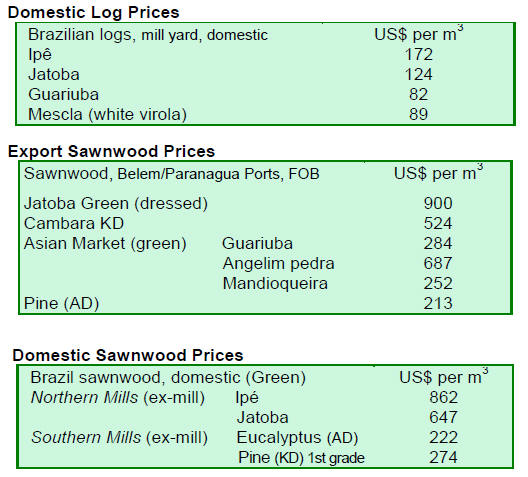
8. PERU
Peru¡¯s efforts to better manage its
Mahogany
harvesting and trade draws praise from CITES
The Standing Committee of the International Convention
for the Protection of Endangered Species (CITES)
concluded their annual meeting on 16 August this year in
Geneva. This meeting was attended by over 300
representatives from 172 member countries of the
convention, NGOs, intergovernmental bodies and private
sector representatives.
In previous meetings CITES expressed serious
concern
over the management of mahogany harvesting in the
Peruvian Amazon. CITES was of the opinion that the
survival of Mahogany was being threatened through over
harvesting and by illegal logging and called for immediate
action by the authorities in Peru.
The efforts by Peru to address the concerns of
CITES,
which includes a drastic reduction of the mahogany export
quota, drew praise from many members of the CITES
Standing Committee.
The president of the South American Regional Standing
Committee of CITES, Xiomara Sanclemente, is on record
as saying ¡°Peru has put in place all the requirements
(sought by CITES) in a short time, which has to be
congratulated¡± this conclusion was reportedly supported
by other officials of CITES.
The CITES meeting noted that the effort by Peru is
an
example of how a country with limited resources can
implement ambitious and effective measures with the
support and advice of the International Tropical Timber
Organization and the CITES secretariat.
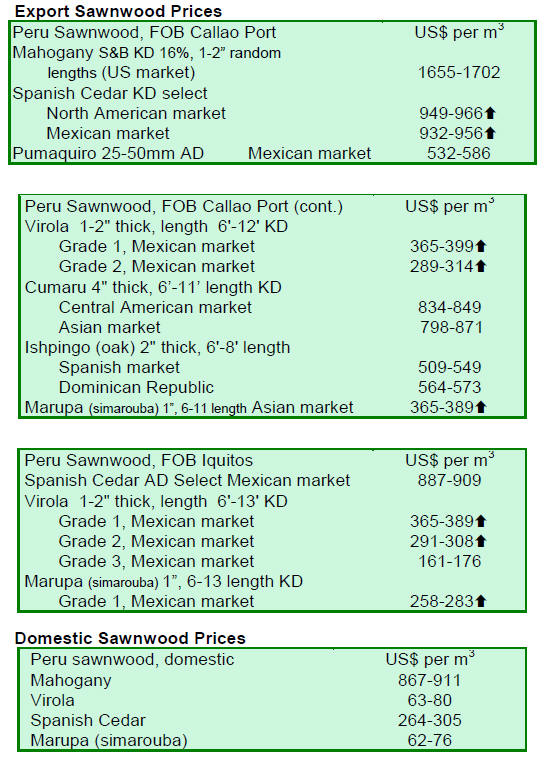
9.
GUYANA
Log and sawnwood export
prices gain as demand
remains strong
During the period under review export log prices
improved. Greenheart log prices increased for fair and
small sawmill quality, there were no exports of standard
sawmill quality Greenheart logs.
Purpleheart standard sawmill quality log prices
remain
stable, however fair and small sawmill quality log prices
dipped. In contrast, Mora log prices gained significantly
for all log qualities.
Export sawnwood prices also improved. Undressed
Greenheart (Prime) was actively traded and attracted a
price of US$848 per cubic metre on the export market.
Undressed Greenheart (Sound) also recorded firm
prices
increasing from US$550 to US$575 per cubic metre.
However, prices for Undressed Greenheart (Select)
weakened from US$818 to US$806 per cubic metre.
Prices for Undressed Purpleheart (Select) improved
recently, increasing from US$925 to US$1,018 per cubic
metre.
Export prices for Undressed Purpleheart increased
but
prices for Prime quality slipped compared to levels
reported for the previous period.
For Dressed Greenheart there was a sizeable drop in
price
in comparison to the previous period, from US$1,018 to
US$975 per cubic metre. Similarly Dressed Purpleheart
prices also experienced a decline from US$933 down to
US$890 per cubic metre.
Guyana¡¯s plywood export earnings benefit from firm demand
Plywood prices in the regional market have been rising
and Guyana¡¯s BB/CC plywood quality is benefiting from
the stronger demand. Prices for BB/CC increased from
US$600 to US$640 per cubic metre.
Exports of Greenheart piles have been very
encouraging
recently and this product is attracting good prices.
Guyana¡¯s Ipe (Washiba) continues maintain its
market
presence and satisfactory price levels on the export
markets in North America and Europe.
Splitwood (Shingle) export prices are currently
favourable
reaching as much as US$955 per cubic metre with the
Caribbean being the leading market for this valuable and
durable product.
Fostering community participation in forest
policy
development and small scale forest enterprises
The Government of Guyana, through the Guyana Forestry
Commission (GFC) and the Forestry Training Centre Inc.
(FTCI), in partnership with the Food and Agriculture
Organization of the United Nations (FAO), has embarked
on a collaborative initiative to build capacity within forest
based communities in Guyana.
This is a continuation of forestry related
collaborative
efforts between FAO and the Government of Guyana that
has been ongoing for some time.
This initiative is aimed at enhancing community
stakeholder participation in implementing forest policy
and guidelines in Guyana and in the development of small
scale forest enterprises.
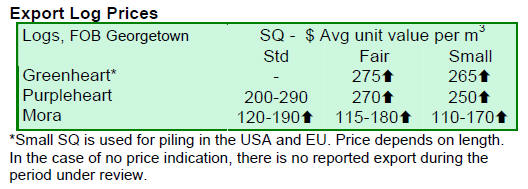
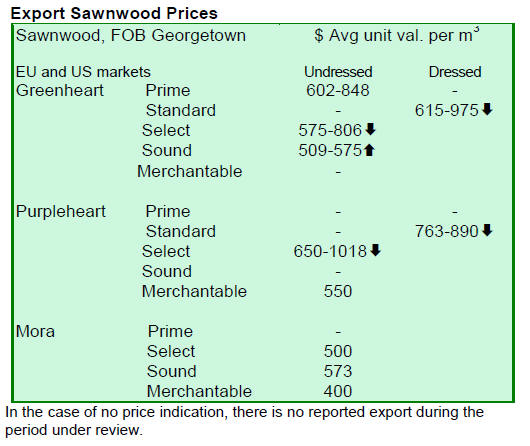
Related News:
¡¡